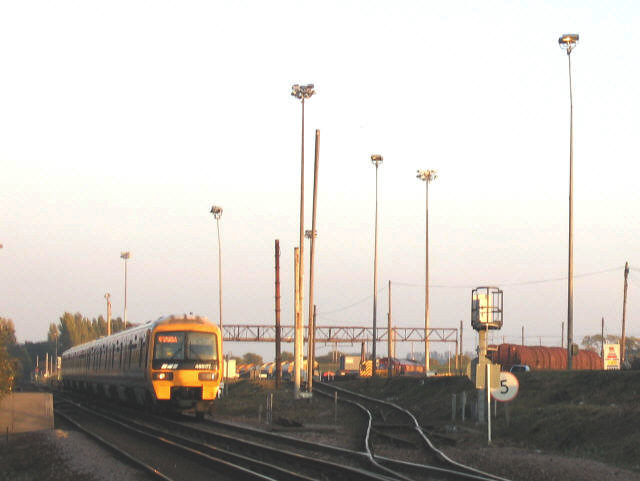Hoo Junction on:
[Wikipedia]
[Google]
[Amazon]
 Hoo Junction is a rail yard on the
Hoo Junction is a rail yard on the
Sketch
of Hoo Junction track plan
website detailing the operations of Hoo Junction
detailing the staff halt
Subterranea Britannica
{{coord, 51, 26, 10, N, 0, 26, 46, E, region:GB_scale:5000_type:landmark_source:wikimapia, display=title Rail yards in the United Kingdom Disused railway stations in Kent Railway stations in Great Britain opened in 1956 Railway stations opened by British Rail Private railway stations Railway sidings in England
 Hoo Junction is a rail yard on the
Hoo Junction is a rail yard on the North Kent Line
The North Kent Line is a railway line which branches off the South East Main Line at St Johns junction west of Lewisham station in Greater London and runs to Rochester Bridge Junction near Strood, Medway where it links to the Chatham Main ...
, near the village of Higham, Kent
Higham is a village, civil parish and Wards and electoral divisions of the United Kingdom, electoral ward in the borough of Gravesham in Kent, England. The village lies south-east of Gravesend and just north-west of Strood, in Medway. The civil ...
and Shorne Marshes, operated by DB Schenker
Schenker AG (trading as DB Schenker) is a subsidiary of Danish logistics company DSV. The company was previously owned by German rail operator Deutsche Bahn, which acquired the subsidiary back in 2002. It comprises divisions for air, land, sea fr ...
. It is between Gravesend
Gravesend is a town in northwest Kent, England, situated 21 miles (35 km) east-southeast of Charing Cross (central London) on the Bank (geography), south bank of the River Thames, opposite Tilbury in Essex. Located in the diocese of Roche ...
and Higham stations, at the junction with the freight-only single-track Hoo branch to the Hoo Peninsula
The Hoo Peninsula is a peninsula in Kent, England, separating the estuaries of the rivers Thames and Medway. It is dominated by a line of chalk, clay and sand hills, surrounded by an extensive area of marshland composed of alluvial silt. The ...
.
Layout
There are up and down yards on either side of the main line, with the single-track Grain branch line entering from the north east. The up yard (south of the main line) consists of 14 sidings and three through roads, with other ancillary sidings. The down yard (north of the main line) consists of 10 sidings and three through roads. Some sidings in the down yard have been taken up. As part of Phase 1 of the Kent Coast Electrification Scheme, the yard at Hoo Junction had a simple overhead catenary system installed in 1959, to accommodate the Class 71 electric locomotives then brought into use. These were equipped with a pantograph to work off the catenary, intended to avoid the exposed third rail which could have added a danger for yard staff. Due to introduction of diesel-electric locomotives the catenary system had become redundant by 1975.Westinghouse Rail Systems
Westinghouse Rail Systems Ltd (formerly ''Westinghouse Signals Ltd'') was a British supplier of railway signalling and control equipment to the rail industry worldwide. Its head office was in Chippenham, Wiltshire, where it manufactured a varie ...
has buildings adjacent to the north perimeter of the yard.
Traffic
The yard re-marshals wagon traffic on the main line and from the branch. The majority of traffic is aggregate wagons, with steel strip carriers are also present. Infrastructure units and ballast trains also use the yard. Container traffic fromThamesport
London Thamesport (formerly just "Thamesport") was a small container seaport on the River Medway, serving the North Sea. It is located on the Isle of Grain, in the Medway unitary authority district of the English county of Kent.
History
Ke ...
used to pass through but this flow ceased around 2014 when the larger container shipping lines started using Thames Gateway instead of Thamesport.
Staff halt
Hoo Junction Staff Halt opened in 1956 in the yard, which it was built to serve. The down platform was on the main line before the junction with thebranch
A branch, also called a ramus in botany, is a stem that grows off from another stem, or when structures like veins in leaves are divided into smaller veins.
History and etymology
In Old English, there are numerous words for branch, includ ...
, at TQ 6950 7369 , while the up platform was only on the main line, at TQ 6980 7364 . This station had an hourly service, which was advertised as being "for staff purposes only".
The station has been closed and demolished.
Down platform
Up platform
See also
*Rail transport in Great Britain
The railway system in Great Britain is the oldest railway system in the world. The first locomotive-hauled public railway opened in 1825, which was followed by an era of rapid expansion. Most of the track is managed by Network Rail, which i ...
References
External links
Sketch
of Hoo Junction track plan
website detailing the operations of Hoo Junction
detailing the staff halt
Subterranea Britannica
{{coord, 51, 26, 10, N, 0, 26, 46, E, region:GB_scale:5000_type:landmark_source:wikimapia, display=title Rail yards in the United Kingdom Disused railway stations in Kent Railway stations in Great Britain opened in 1956 Railway stations opened by British Rail Private railway stations Railway sidings in England